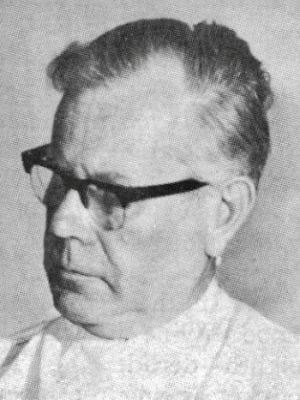Thomas Barlow

Thomas Geoffrey Barlow (1915-1975) was an English Orthopaedic surgeon.
He was known for his research on congenital hip dysplasia, not only developing the eponymous testing manoeuvre for early detection, but also comprehensively describing the ongoing treatment and management.
Eponymously remembered for Barlow maneuver (Barlow test) a screening tool for developmental dysplasia of the hip in infants
Biography
- Born on September 25, 1915 in Eccles, England
- Attended Manchester Grammar School
- 1939 – Graduated medicine from Victoria University, Manchester
- Commenced work at the Royal Albert Edward Infirmary
- 1941 – Joined Royal Air Force. Predominantly worked at the RAF Hospital, Rauceby
- 1956 – Appointed consultant orthopaedic surgeon to Ashton Hyde and Glossop hospitals
- Died on May 25, 1975
Medical Eponyms
Barlow maneuver (Barlow test)
Clinical examination test, performed on infants screening for developmental dysplasia of the hip
1961 – Whilst working at the Hope Hospital, Salford in Manchester, Barlow first presented his test in a paper read to the British Orthopaedic Association at Manchester on April 14, 1961. His test was based on the results of examining 7,742 children for congenital dislocation of the hip within a week of birth.
1962 – Barlow published details of his test in the Journal of Bone and Joint Surgery. He referenced Ortolani and his test, describing his own test as a modification of Ortolani’s test to detect more subtle cases of dislocated femoral heads.
In 1936 Ortolani described a simple test which would establish a diagnosis of congenital dislocation of the hip in children one year old. Unfortunately it was published in a little known Italian paediatric journal and did not receive the attention it deserved. Ortolani’s test, and indeed my own, which I will describe later, depend upon the fact that the dislocation is a postero-inferior one.
In Ortolani’s test the child is laid on its back with the hips flexed to a right angle and the knees flexed. Starting with the knees together, the hips are slowly abducted, and if one is dislocated, somewhere in the 90 degrees arc of abduction the head of the femur slips back into the acetabulum with a visible and palpable movement described by Ortolani as a “click.”
Barlow found the Ortolani test satisfactory for children up to 12 months of age (using it in his outpatient clinic follow up), but less than satisfactory in newborns. He found that occasionally, when the hips were abducted, the dislocated femoral head slid so smoothly over the low rim of the acetabulum that no ‘palpable click’ was felt and the hip reported as normal.
Barlow’s modification of Ortolani’s test compromised two parts:
1) The baby is placed on its back with the legs pointing toward the examiner. The hips are flexed to a right angle and the knees are fully flexed. The middle finger of each hand is placed over the greater trochanter and the thumb of each hand is applied to the inner side of the thigh opposite the position of the lesser trochanter. The thighs are carried into mid-abduction, and forward pressure behind the greater trochanter is exerted by the middle finger of each hand in turn while the other hand holds the opposite femur and pelvis steady. If the femoral head slips forward into the acetabulum the hip has been dislocated. If there is no movement of the femoral head the femoral hip is not dislocated
2) The second part of the test consists in applying pressure backwards and outwards with the thumb on the inner side of the thigh. If the femoral head slips out over the posterior lip of the acetabulum and back again immediately the pressure is released, the hip is “unstable” – that is to say the hip is not dislocated but is dislocatable.
Barlow 1962
1963 – Barlow published a review of his 1962 publication and test having now examined 11,989 children for congenital dislocation between 1957 and 1963. He confirmed that abnormal laxity of hips is much more common than previously suspected (incidence of I in 60); and that about 60% recover spontaneously in the first week of life.
Major Publications
- Barlow TG. Early diagnosis and treatment of congenital dislocation of the hip. JBJS. 1962; 44–B (2): 92–301
- Barlow TG. Early diagnosis and treatment of congenital dislocation of the hip. Proc R Soc Med. 1963; 56(9): 804-806
- Barlow TG. Congenital dislocation of the hip. Early diagnosis and treatment. Lond Clin Med J. 1964; 5: 47-58.
References
Biography
- Biography: Barlow, Thomas Geoffrey (1915 – 1975). Plarr’s Lives of the Fellows Online. Royal College of Surgeons of England.
- Obituary: T.G. Barlow (1915 – 1975). British Medical Journal, 14 Jun 1975
Eponymous terms
- Klisic PJ. Congenital dislocation of the hip–a misleading term: brief report. J Bone Joint Surg Br. 1989 Jan;71(1):136.
- Noordin S, Umer M, Hafeez K, Nawaz H. Developmental dysplasia of the hip. Orthop Rev (Pavia). 2010 Sep 23;2(2):e19
Eponym
the person behind the name
Physician in training. German translator and lover of medical history.
